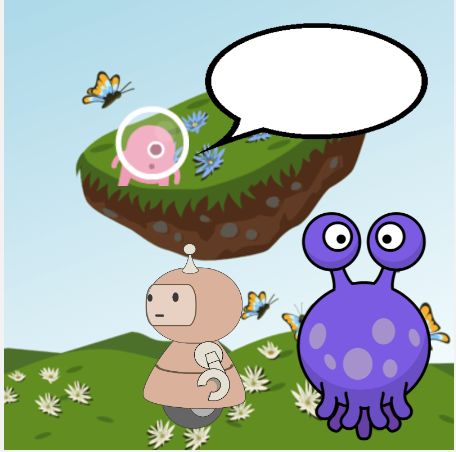Lesson 10: Text
45 minutes
Overview
This lesson introduces Game Lab's text commands, giving students more practice using the coordinate plane and parameters. This is the last type of element that students will be placing on the screen - after this, students will focus on how they can control the movement and interactions of these elements. The lesson begins with asking students to caption a cartoon created in Game Lab. They then move on to Code Studio where they practice placing text on the screen and controlling other text properties, such as size. Students who complete the assessment early can go on to learn more challenging blocks related to text properties.
Question of the Day: How can we use text to improve our scenes and animations?
Standards
AP - Algorithms & Programming
- 2-AP-12 - Design and iteratively develop programs that combine control structures, including nested loops and compound conditionals.
- 2-AP-13 - Decompose problems and subproblems into parts to facilitate the design, implementation, and review of programs.
- 2-AP-17 - Systematically test and refine programs using a range of test cases.
- 2-AP-19 - Document programs in order to make them easier to follow, test, and debug.
Agenda
Objectives
Students will be able to:
- Place text on the screen using a coordinate plane.
- Use arguments to control how text is displayed on a screen.
Preparation
- Check the "Teacher's Lounge" forum for verified teachers to find additional strategies or resources shared by fellow teachers
- If you are teaching virtually, consider checking our Virtual Lesson Modifications
Links
Heads Up! Please make a copy of any documents you plan to share with students.
For the teachers
- Text - Slides
Teaching Guide
Warm Up (5 minutes)
Journal

Display: Display the cartoon for students to see.
Prompt: Look at the cartoon that was made in Game Lab. What do you think the alien should be saying?
Share: Allow volunteers to share out their ideas.
Remarks
We've had a lot of fun drawing things and using our sprites, but there's been one thing missing from our Game Lab pictures: text! Today we're going to learn how to add text to Game Lab projects.
Question of the Day: How can we use text to improve our scenes and animations?
Activity (35 minutes)
Transition Send students to Code Studio.
Guide to Programming Levels: Additional guidance for programming levels is provided in the CSD Guide to Programming Levels. This document includes strategies and best-practices for facilitating programming levels with students.
Formative Assessment: This level can be used as a formative assessment. A rubric is provided in the level, and written feedback can be given to students. Click here to learn more about giving feedback to students.
Wrap up (5 minutes)
Journal
Question of the Day: How can we use text to improve our scenes and animations?
Prompt: You've drawn with both text and shapes on the screen.
- What are two ways drawing with text is similar to drawing shapes?
- What is one way that drawing with text is different from drawing with shapes?
Share: If there is time, allow students to share out their answers.
Discussion Goal: Student answers to the question may vary, but some similarities are that they both use the coordinate plane and that they are drawn automatically, unlike sprites, which must use the drawSprites() command. One possible difference is that it is more difficult to control the exact size of text since the amount of text and font size are not as specific as height and width parameters.
This work is available under a Creative Commons License (CC BY-NC-SA 4.0).
If you are interested in licensing Code.org materials for commercial purposes contact us.





